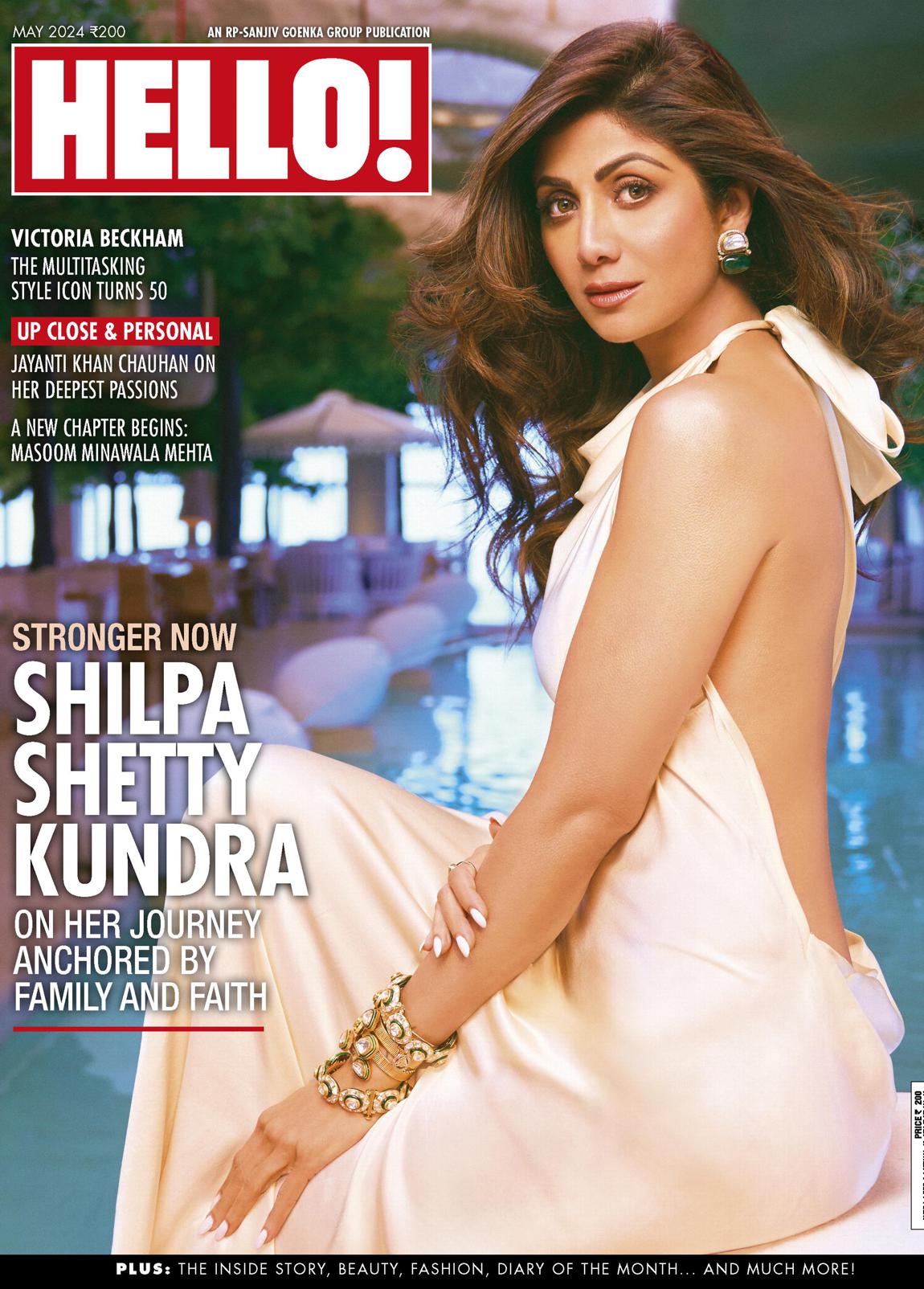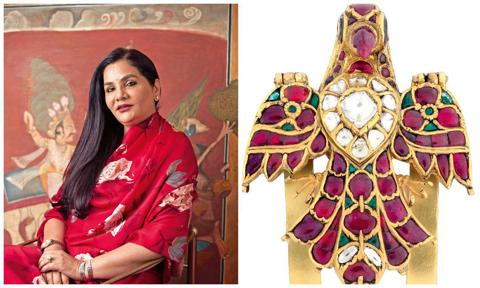
The Museum of Meenakari Heritage (MOHM) by jewellery designer Sunita Shekhawat, is housed in the jewel-box shaped, three-storey pink sandstone. Shekhawat Haveli, next to the Rajmahal Palace in the heart of Jaipur, also home to the jewellery maison’s flagship store is a world first. It’s the only museum of its kind dedicated to the ancient art of Meenakari, enamelling on jewellery, which is the métier that has defined the work of Jodhpur-born, Sunita Shekhawat for a quarter of a century.
The Meenakari art form traced a circuitous route from Taxila in modern-day Rawalpindi in 2AD to 16th century France Goa, and the Deccan, Hyderabad, Benares (now Varanasi), and eventually Jaipur. It journeyed via the Mughals, who introduced it from Persia,
Mughals, who introduced it from Persia, added their flourishes to this art form. Forming a bridge from a colourful past, with royal, noble and religious patronage from Europe to the Mughals, as shown in the museum, to present-day customer demands from royal families in India and abroad, and notable buyers like Nita Ambani, Sunita and her jewellery karigars (artisans) have elevated this art form with a vast colour palette, and a superlative bespoke experience that begins in the special by appointment- only floor of her flagship.

A Museum Of Marvels
Curated by jewellery historian Usha Balakrishnan, with 300 images from 15 museums, private collections and auction houses internationally, the exhibition spread over 2,200sq ft on the ground floor of the building, depicts the ‘heavenly art’ (the literal translation of the word ‘meenakari’, where karigars apply a vitreous paste coloured with oxidized metal to the front and back of jewellery pieces, for decorative and practical reasons), in its various iterations.
It explores the history, techniques, types, patrons, motifs and colours of this art, which finds its apogee during the Mughal period. Strangely, from all the cities Meenakari popped up in — even in Murshidabad in Bengal, Assam, Kashmir and Himachal Pradesh — and parts of Hyderabad.
Just a month since opening its wood and glass doors to the public, luminaries of the art and jewellery world are already taking note.
“I’ve just had a visit by Gary Tinterow, Director of the Museum of Fine Arts in Houston,” says Sunita Shekhawat. He saw our reproduction of the sarpech (turban ornament worn by the Nizam of Hyderabad), and he was amazed.
I told him when I come to Houston and see the original in your museum, I can do a better job. He replied, ‘You haven’t gone wrong anywhere! Just by looking at a digital photo, how were you able to reproduce it?’. One thing is certain — all the enamelling techniques originally used by the French in Limoges, with names such as cloisonné, champlevé, plique-à-jour and basse-taille, have been expounded upon in the 60 original pieces by Sunita.
These pieces, showcased in the museum, include examples such as Sunita’s version of the pendant once worn by Muhammad Adil Shah of Bijapur (from a 1645 painting) — an emerald with red enamel petals.

Colour And Love’s Labour
With her very first meenakari piece made for Maharaja of Jodhpur, Gaj Singhji II (a set of peacock feather buttons), cufflinks for Yuvraj Shivraj Singh and earrings for Maharani Hemlata, it was the abundance of colour in her hometown of Jodhpur that ignited Sunita’s love for the craft .
“Memories of my childhood, from the bangle seller to trips to Sojati Gate, and the colourful and the colourful saris of Tayabji [Padma Shri recipient, craftsman Tayab Khan], colour was everywhere,” says Sunita, who moved to Jaipur after marriage, and saw first-hand the enamelling techniques that saw first-hand the enamelling techniques that she and her karigars would go on to master.
“In the middle of the 17th century, Indian enamellers wanted to replicate the colours of enamellers wanted to replicate the colours of gemstones, so the predominant colours were ruby, emerald green, sapphire blue and diamond white,” says Usha Balakrishnan. Karigars patronised by Maharaja Jai Singh (the founder of Jaipur) would actually use ground gemstones to create their colors. With romantic names such as khoon-e-kabooter (pigeon blood, red), tote ka par (parrot’s feather, green) and ferozi (opaque turquoise) Indian enamellers devised their own vocabulary inspired by nature, called ‘Misal’.
Today, Sunita has developed 300 colours with her artisans, which she uses to adorn the back of her polki (uncut diamonds), pearls and precious gemstone jewellery, as well as the front.
“The human eye sees 200 colours, for me, it’s God’s gift that I am able to recognise these colour tones even on different materials,” says Sunita, who has added to the colourful terminology with names like neel pushp and neel var. “Today, we use ground crystal — it used to be from Murano, now we get colours from Japan.”
Crafting for royalty
A decade ago, Maharani Divya Kumari of Bharatpur reached out to Sunita to create the wedding set for her future daughter-in-law (bride of her son Anirudh).
“I wanted the red colour to be visible from the front,” says Divya Kumari, who had several sittings with Sunita, poring over swatches of red enamel to find the perfect red shade for her set, which was custommade for her.”
“I wanted this to go on the aad [bridalhathphool [hand ornament], borla and mehri [head ornaments].”She chose red, green and white for her set, with the Rohira flower of Rajasthan as. “My immediate reaction to the jewellery once made, was, ‘You’ve created the colours of a Fabergé egg!’
Divya Kumari’s son Anirudh says that Sunita’s professionalism is unmatched. She will show you her designs, make edits while you are there take notes, follow up and send you reminders for” he says of a process that can take from six months to a year. “You have to lock in from six months to a year. “You have to lock in your design first, of course,work; you can’t make changes midway!
Even details such as using Benarasi silk thread with gold and silver as a necklace tie adds to the bespoke touch. And all this takes place in the tastefully appointed bespoke rooms a floor below the museum — with individual ceilings.
All this takes place in the tastefully appointed bespoke rooms a floor below the museum with individual ceilings painted in motifs such as the khas bagh (garden) motif, or the Abhaneri (step well)- all connected via a secret corridor that allows store managers to ferret their bijoux from their vault to the bespoke rooms.
Sunita, who had recently created a pink and green necklace and earrings set for Nita Ambani for her son’s pre-wedding celebrations in Jamnagar, is making another set of custom-made jewellery for the industrialist philanthropist.
“We do our sketches, renders, dimensions, colour — everything is written,” she says, “We can’t do this degree of customisation for everyone, of course.” She has thousands of floral designs to choose from, inspired by Mughal art and marble inlay, textiles and miniature paintings. Sunita has also started working on her new collection, for July-August. “Unlike garments which have a Fall/Winter and Spring/Summer concept, my collections depend on my mood. I may do one, two or three collections a year.”
Her modern designs explore organic forms of flora, like 3D flowers. “Right now, I’m working on Ottoman textile motifs, like the tulip,” says Sunita. “Did you know there are 62 varieties of tulips? I have to decide the colours and shapes for my meenakari designs, a lot of hard work!”
Sunita says that her designs go beyond Meenakari and that boundaries are now blurring; she’s also explored Art Deco designs, with two-tone jewellery in diamonds and coloured stones. Meenakari karigars, past and present, imbued and absorbed techniques and styles from one another.
For them, meenakari work was the highest form of self-expression, the value of which only the wearer would truly know.
“All the credit for our meenakari work goes to my artisans here in Jaipur,” says Sunita.“The colonisers may have taken away our best pieces, but the skill of meenakari is alive and thriving, here in Jaipur”.

Photos: Sunita Shekhawat
This story has been adapted for the website from HELLO! India’s May 2024 issue. Get your hands on the latest issue right here!
- Quick links
- Indian jewellery
- Bridal Jewellery





